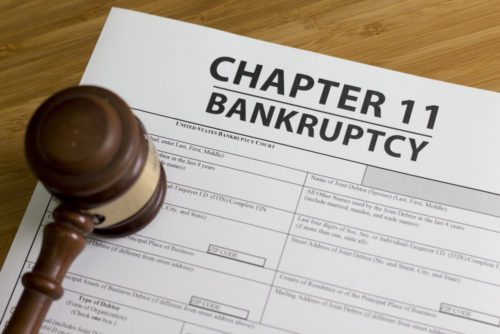Chapter 11 bankruptcy is one of five types of bankruptcies and is known as the “reorganization bankruptcy.” It’s designed to allow a business to keep operating while they reorganize finances to pay their bills. Chrysler and General Motors filed Chapter 11 bankruptcies back-to-back in 2009 to temporarily block creditors from taking action against them to collect on their debts. Both car manufacturers successfully restructured and are still operating today.
Chapter 11 isn’t reserved for major corporations — small businesses and individuals can also file. The inability to pay medical debt is the top reason individuals file for bankruptcy, with two-thirds of Americans citing medical issues as the main reason for their financial problems.
According to a Kaiser Family Foundation survey, four in 10 American households with medical debt problems report a major impact on their families. A Chapter 11 reorganization may be the best option to renegotiate terms with medical creditors without a family losing their home or small business.
Table of Contents
Chapter 11 Bankruptcy Explained
When a business or individual files for Chapter 11, their personal and/or company assets are protected while they negotiate new repayment terms. Creditors are not allowed to take action action to collect on debts against the individual or company for a certain amount of time.
Once the petition is filed, the person or company has four months to come up with a reorganization plan (which should include reducing expenses and downsizing) to repay their debts. The plan will become the new contractual agreement between the debtor and creditors, detailing how the debts will be repaid.
Although Chapter 11 can benefit many Americans, it’s the most complicated bankruptcy to file — in 2018, debtors filed 480,933 Chapter 7 bankruptcies, 290,566 Chapter 13 bankruptcies, and only 7,735 Chapter 11 bankruptcies. Here’s more on how a Chapter 11 works for business and personal filings:
Chapter 11 Business Bankruptcy
Many businesses use this type of bankruptcy as a “do-over” to find ways to operate more efficiently and pay creditors back. Chapter 11 is the best choice for businesses that are more valuable when operating than shut down and liquidated. Small business Chapter 11s (businesses with debts of $2,566,050 or less) are less complex and move faster than larger company filings.
Once filed, the company owner becomes a “debtor in possession,” meaning they are in possession of the business assets and must bring the business back out of bankruptcy with the help of a court-appointed bankruptcy trustee or administrator. They have four months to create a restructured plan for the creditors to approve, although the deadline can be extended to up to 18 months.
After 18 months, the creditors can propose their own reorganization plans. In larger company filings, the creditors vote to accept or reject the plan. Dischargeable debts that the business is no longer responsible for will be removed, once the court confirms the plan.
Not all Chapter 11 business bankruptcy filings are voluntary — in some cases, a Chapter 11 can be forced if three or more creditors file a petition in bankruptcy court against the company to force a reorganization.
Chapter 11 Personal Bankruptcy
As the cost of healthcare increases, some individuals may have too much debt to qualify for a Chapter 13 reorganization plan and must turn to filing for Chapter 11.
Individuals can file a Chapter 11 personal bankruptcy if they have an extreme amount of debt — over the Chapter 13 requirements of $419,275 in unsecured debt and $1,257,850 in secured debt.
Chapter 11 allows a debtor to lower their monthly payments by reducing the interest rates and extending the repayment terms. Their assets are protected and they are not required to sell them to pay their debts. Any dischargeable debts the individual will not be responsible for will be erased by the court after all the payments are made, according to the plan.
How Long Does Chapter 11 Bankruptcy Take?
A reorganization bankruptcy is the most expensive and longest type of bankruptcy. Once the process is initiated, the debtor has four months to file a restructuring plan. Some Chapter 11 cases wrap up soon after the plan is submitted, although more complicated cases can take up to two years to complete. Here are the steps a person or business goes through during the Chapter 11 bankruptcy:
- Credit counseling: Individuals must complete a credit counseling course by an approved agency prior to filing a case to learn more about debt and how it affects credit history.
- Chapter 11 petition: To submit a petition, a company or individual must prepare the appropriate financial reports to show debts, assets, income, and expenses.
- Automatic stay: Once the petition is filed, an “automatic stay” is triggered to prohibit creditors from continuing their collection efforts.
- Monthly operating reports: Debtors must prepare and file a monthly report of income and expenses to submit to the creditors and the bankruptcy court for review.
- Initial debtor interview: The appointed administrator or U.S. Trustee meets with the debtor to learn about the case and confirm the debtor understands their responsibilities.
- Meeting with creditors: A public hearing is scheduled around 30 to 45 days after the filing to give creditors a chance to question the debtor under oath about the petition.
- Disclosure statement: The statement must be mailed to all creditors and parties of interest explaining how creditors may participate in the bankruptcy process.
- Hearing on the disclosure statement: A hearing is held where parties of interest and creditors can attend to the mailed statement’s wording.
- Proposed plan of reorganization submission: Debtors have four months to submit a plan of reorganization, although they can request extensions for up to 18 months. After 18 months, creditors can present their own plan.
- Confirmation hearing: The hearing takes place to ask the judge to approve the reorganization plan. If approved, it becomes a new contract with each of the creditors.
- Start plan payments: Once the court has approved the plan, a debtor starts payments according to the approved plan.
Is Chapter 11 Bankruptcy Bad?
When a business or individual is in deep financial trouble, bankruptcy is not “bad.” It allows for a fresh start to get finances and debts back on track. Here are the pros and cons of a Chapter 11 petition:
Chapter 11 Bankruptcy Pros:
- Immediate stop of collection activity by creditors;
- Reduced amounts owed in interest;
- Offers relief from overwhelming bills;
- Businesses remain operational;
- Assets like homes and vehicles are protected;
- Court may dismiss some or all of the debt;
- Creditors are generally receptive;
Bankruptcy Cons:
- Will affect credit score;
- Potentially longer process;
- More complex;
- Requires monthly report preparation and filing;
- Chapter 11 process is more expensive;
- Petition can be rejected;
- Court can impose restrictions;
- Needs the court’s approval.
Image Source: https://depositphotos.com/





